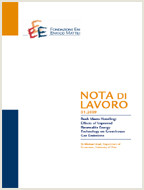Delineating Spring Recharge Areas in a Fractured Sandstone Aquifer (Luxembourg) Based on Pesticide Mass Balance

12.09.2014
J. Farlin, L. Drouet, T. Gallé, D. Pittois, M. Bayerle, C. Braun, P. Maloszewski, J. Vanderborght, M. Elsner, A. Kies
Q5, Q53
Spring Protection Zones, Atrazine, Luxembourg, Fractured Rock, Groundwater Pollution
Climate Change and Sustainable Development
Carlo Carraro
A simple method to delineate the recharge areas of a series of springs draining a fractured aquifer is presented. Instead of solving the flow and transport equations, the delineation is reformulated as a mass balance problem assigning arable land in proportion to the pesticide mass discharged annually in a spring at minimum total transport cost. The approach was applied to the Luxembourg Sandstone, a fractured-rock aquifer supplying half of the drinking water for Luxembourg, using the herbicide atrazine. Predictions of the recharge areas were most robust in situations of strong competition by neighbouring springs while the catchment boundaries for isolated springs were extremely sensitive to the parameter controlling flow direction. Validation using a different pesticide showed the best agreement with the simplest model used, whereas using historical crop-rotation data and spatially distributed soil-leaching data did not improve predictions. The whole approach presents the advantage of integrating objectively information on land use and pesticide concentration in spring water into the delineation of groundwater recharge zones in a fractured-rock aquifer.
***
This is a pre-print version of the article "Delineating spring recharge areas in a fractured sandstone aquifer (Luxembourg) based on pesticide mass balance" published in Hydrogeology Journal June 2013, Volume 21, Issue 4, pp 799-812, DOI 10.1007/s10040-013-0964-5
